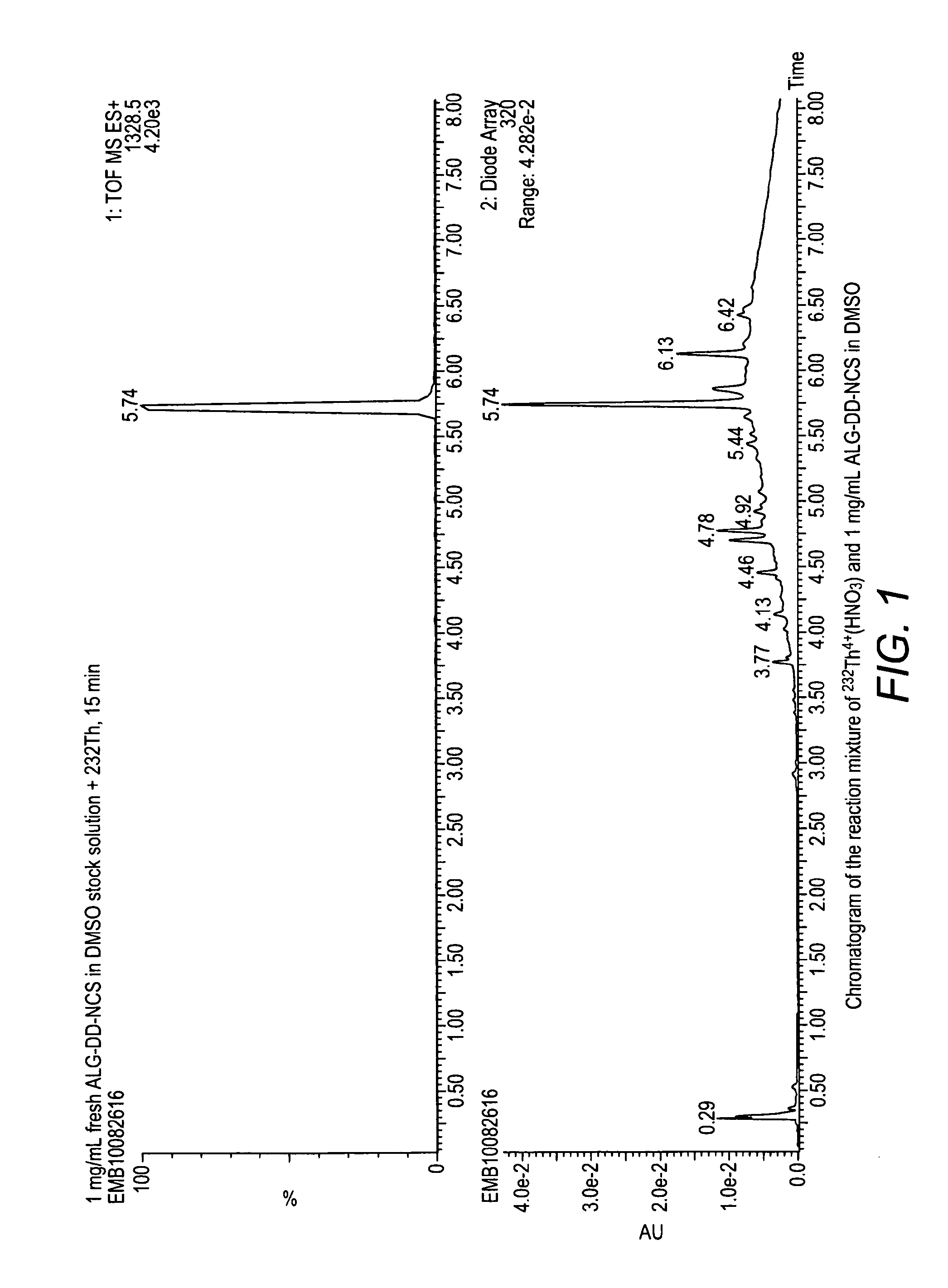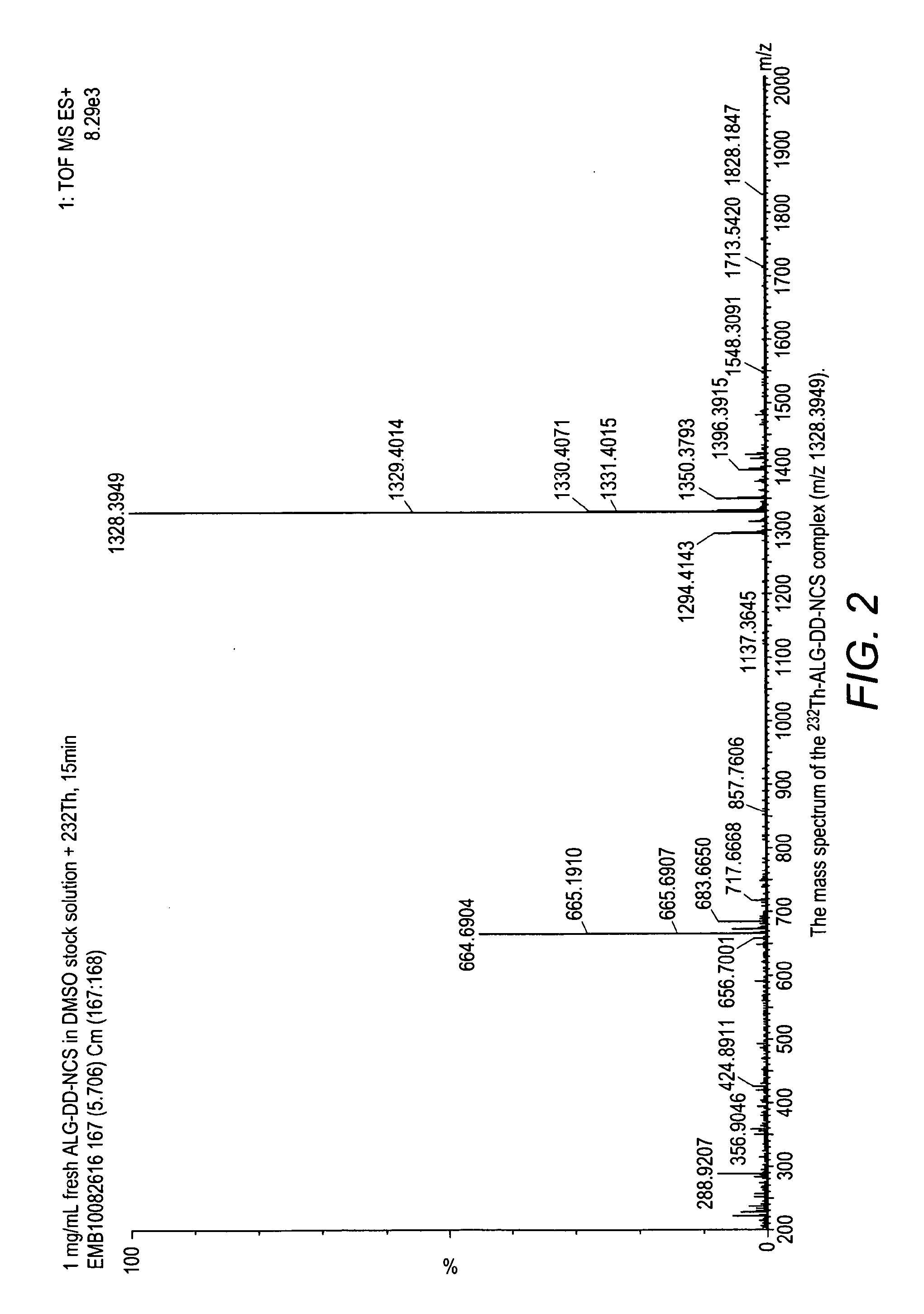Alpha-emitting complexes
a complex and alpha-emitting technology, applied in the field of alpha-emitting complexes, can solve the problems of unsatisfactory liposome administration, undesired systemic toxicity, and difficulty in commercial production and distribution of radiopharmaceuticals based on these radionuclides
- Summary
- Abstract
- Description
- Claims
- Application Information
AI Technical Summary
Benefits of technology
Problems solved by technology
Method used
Image
Examples
example 1
Isolation of Pure Thorium-227
[0114]Thorium-227 is isolated from an actinium-227 cow. Actinium-227 was produced through thermal neutron irradiation of Radium-226 followed by the decay of Radium-227 (t1 / 2=42.2 m) to Actinium-227. Thorium-227 was selectively retained from an Actinium-227 decay mixture in 8 M HNO3 solution by anion exchange chromatography. A column of 2 mm internal diameter,
length 30 mm, containing 70 mg of AG®1-X8 resin (200-400 mesh, nitrate form) was used. After Actinium-227, Radium-223 and daughters had eluted from the column, Thorium-227 was extracted from the column with 12 M HCl. The eluate containing
[0115]Thorium-227 was evaporated to dryness and the residue resuspended in 0.01 M HCl.
example 2
Synthesis of ALG-DD-NCS
[0116]
[0117]3-benzyloxy-1-methyl-4-(2-thioxothiazolidin-1-yl)carbonyl-2(1H)-pyridinone (synthesized according to Raymond, K.; Xu, J., U.S. Pat. No. 5,624,901) (2.22 mmol, 0.8 g), triethylamine (0.31 mL, 2.22 mmol) and DMAP (5 mg) was added to a solution of [5-Amino-6-((2-amino-ethyl)-{2-[bis-(2-amino-ethyl)-amino]-ethyl}-amino)-hexyl]-carbamic acid tert-butyl ester (BocLys-H(2,2)amine) (synthesized according to Raymond, K.; Corneillie, T. M.; Xu. J. WO 2008 / 063721 A2) (0.204 g, 0.505 mmol) in dichloromethane (80 mL). This mixture was stirred at room temperature overnight and then evaporated to dryness. The residue was dissolved in dichloromethane and loaded onto a flash silica gel column and eluted with a gradient of 2-8% methanol in dichloromethane. The appropriate fractions were collected and evaporated to dryness to give ALG-001 (1) (−0.4 g) as pale beige thick oil.
[0118]MS (ESI, pos): m / z 1369 [M+H]+, m / z 1391 [M+Na]+
[0119]ALG-001 (1) (280 mg, 0.205 mmol) ...
example 3
Synthesis of a Symmetric 3,2-HOPO Containing Chelator
[0124]
[0125]Sodium hydride (60.1 g as 60% dispersion in mineral oil, 1.5 mol, 5 eq.) was charged in a flask and tetrahydrofuran (1 L) was added. Dimethyl malonate (172 mL, 1.5 mol, 5 eq.) was added drop-wise over 1.5 h; the temperature of the reaction mixture was kept below +10° C. The reaction mixture was then diluted with tetrahydrofuran (400 mL). A solution of 4-nitrobenzyl bromide (65.0 g, 0.3 mol, 1 eq.) in tetrahydrofuran (170 mL) was slowly added over 30 min to the above-prepared mixture under vigorous shaking. After 30 min of stirring at 0° C., the reaction mixture was poured into brine (1 L saturated NaCl solution) and left stirring overnight at ambient temperature, yielding a white precipitate. The mixture was then diluted with methyl tert-butyl ether, and the precipitate was filtered off and dissolved in hot ethanol. The ethanolic mixture was filtrated, and the filtrate was concentrated to the small volume, from which 2...
PUM
| Property | Measurement | Unit |
|---|---|---|
| Temperature | aaaaa | aaaaa |
| Fraction | aaaaa | aaaaa |
| Fraction | aaaaa | aaaaa |
Abstract
Description
Claims
Application Information
 Login to View More
Login to View More - R&D
- Intellectual Property
- Life Sciences
- Materials
- Tech Scout
- Unparalleled Data Quality
- Higher Quality Content
- 60% Fewer Hallucinations
Browse by: Latest US Patents, China's latest patents, Technical Efficacy Thesaurus, Application Domain, Technology Topic, Popular Technical Reports.
© 2025 PatSnap. All rights reserved.Legal|Privacy policy|Modern Slavery Act Transparency Statement|Sitemap|About US| Contact US: help@patsnap.com



